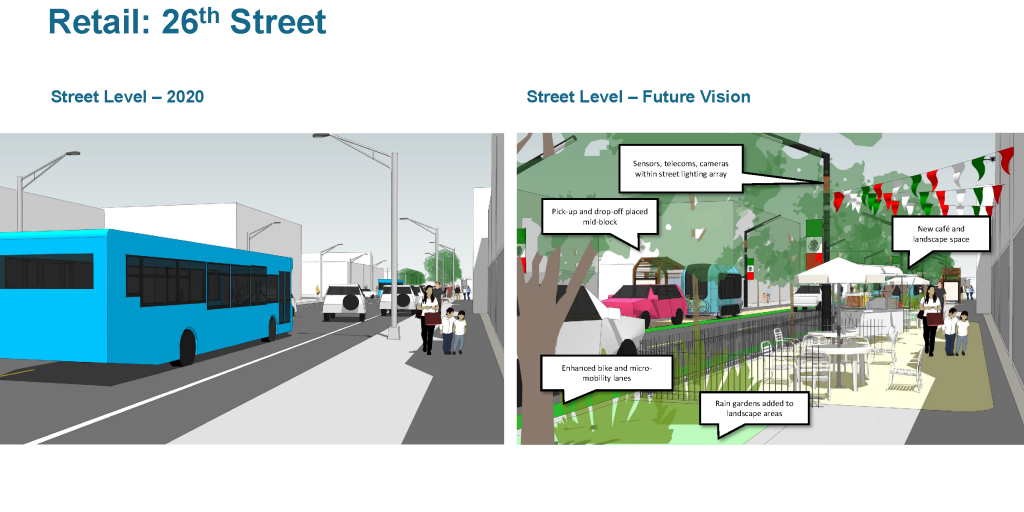Streets of the post-pandemic future: Retrofitting city streets for 21st century needs
Since the onset of the COVID-19 pandemic, streets have become an integral part of our public health infrastructure—they’re spaces to walk, exercise, play, perform, dine and more safely convene. Street amenities once considered “nice-to-haves” have become “must-haves” as we seek to make our cities more safe, resilient and responsive.
Driven by this sense of urgency, cities have partially closed streets to create car-free spaces for pedestrians and cyclists. Restaurants and businesses have reimagined outdoor spaces to provide open-air, socially distanced customer experiences. And there’s been an increase in deliveries and curbside services, demanding new strategies at the street’s edge.
We’re also entering a new era of mobility. From hand-held technologies and remote sensing to on-demand and autonomous vehicles with optimal route selection, our streets will need to continue to adapt to meet this new future.
At the same time, we have certain expectations about what our streets should look like and how they should perform. In addition to connectivity within a broader transportation network to traffic management, site access and ensuring pedestrian and cyclist safety, we also want to generate economic development and vibrant public spaces. The beautification and landscaping of our streets also plays an essential role in reducing heat island effects and supporting local habitat.
For new cities and urban districts, a blank canvas approach can be taken to future street design. But for mature cities, existing built infrastructure and an established street pose different challenges. In late 2019, City Tech Collaborative and Skidmore, Owings, and Merrill (SOM) partnered to explore how existing Chicago streets could evolve to meet 21st century needs through the Streets of the Future initiative.
The process brought in more than 30 subject matter experts across urban planning, design, engineering, public and private transportation services, research and academic fields to investigate solutions for three street types—arterial, neighborhood commercial and residential—across a socioeconomically and ethnically diverse set of communities.
The work reveals a need to adjust sidewalks and curbs to organize diverse modes of transportation and allocate specific pick-up and drop-off sites for transit, rideshare and delivery. Micro-mobility parking stations need to be close to transit stops, while mid-block pedestrian crossings can better link sidewalks and destinations to one another. On-street parking can be reduced, maximizing area for cafés, gathering spots and landscaping.
On residential streets, new ways to accommodate communal play and landscaping can be incorporated when vehicle access is managed and controlled. Opportunities also arise for digital infrastructure to better communicate with vehicles, environmental sensing and monitoring, and potentially integrate with smart lighting infrastructure.
Chicago is not alone in thinking about the future of its streets. In New York, 14th Street achieves a better bus flow and a safer space for pedestrians, cyclists and micro-mobility users by limiting personal vehicle access between 6 a.m. to 10 p.m. to pick-up and drop-off activity only. Across the pond, New London Architecture published an investigation into how London’s streets can adapt to changes in mobility needs, while being mindful of efficient urban design, environmental sustainability and social inclusivity.
Many of the design interventions that have emerged on our streets and sidewalks as COVID-19 response tactics are solving a problem we never anticipated—but these are not new concepts. It’s time for cities to determine which interventions are here to stay, and how decision-making processes can include public health, safety, flexible use and resiliency moving forward. As we envision our streets of the future, we have an opportunity to leverage this collective urgency to transform temporary solutions into permanent features of our built environment.
Kate Calabra is the manager of partnership development at City Tech Collaborative, and works to facilitate strategic partnerships and collaboration to build solutions for critical city challenges. Contact her at [email protected].
Chris Hall is an urban strategy leader for Skidmore, Owings & Merrill (SOM). Hall’s experience includes large-scale spatial planning, master planning, investment frameworks, infrastructure, transit-oriented development, development feasibility, strategy, policy planning, zoning and stakeholder and community engagement. Contact him at [email protected].



















